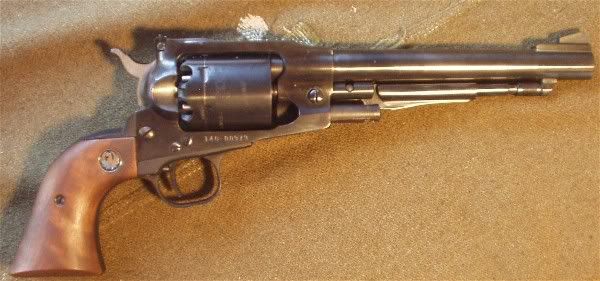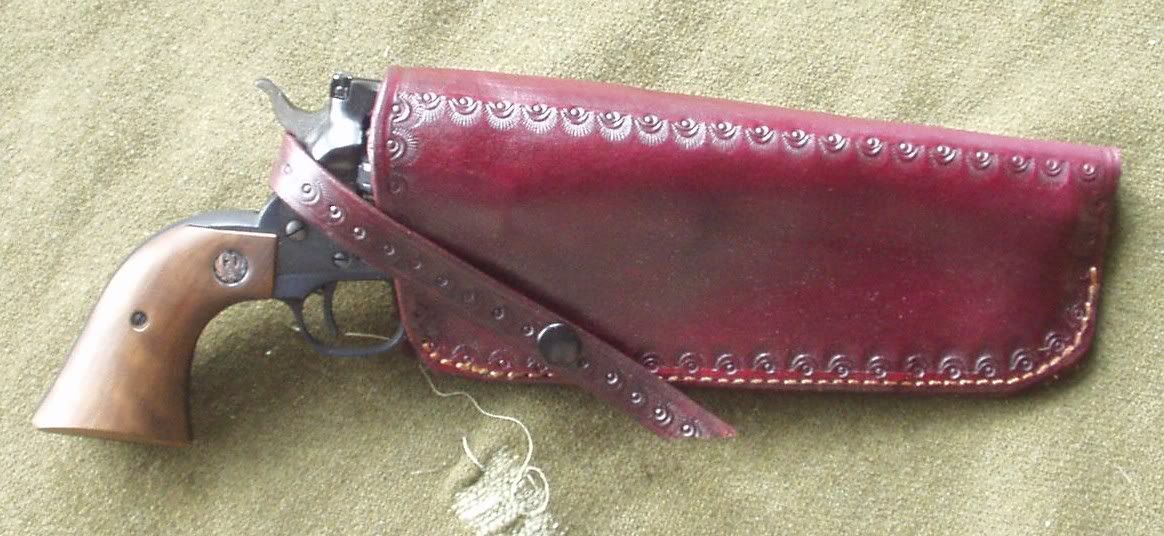 I posted when I bought this Ruger Old Army from the first year of production. There are many opinions about this gun but the consensus seems to be that it is the epitome of the cap'n'ball revolver. Would that every trooper in the Civil War could have had one of these or the newer Vaquero (fix sighted) model. They would have been happy to have had dependable coil springs, excellent metallurgy and interchangeable parts with which to work. Still, in today's world, there are some criticisms of the Ruger Old Army.
I posted when I bought this Ruger Old Army from the first year of production. There are many opinions about this gun but the consensus seems to be that it is the epitome of the cap'n'ball revolver. Would that every trooper in the Civil War could have had one of these or the newer Vaquero (fix sighted) model. They would have been happy to have had dependable coil springs, excellent metallurgy and interchangeable parts with which to work. Still, in today's world, there are some criticisms of the Ruger Old Army.First and foremost criticism seems to be that the nipples aren't of uniform size. Correspondents and others seem to go on and on about the difficulty in settling on either no. 10 or 11 caps. Seems to me that you can just polish these down to accept #10 caps OR buy new nipples and drive on.
 Well that about does it for criticism. Now to carrying the gun. I ordered a 120 holster from Simply Rugged. This copy of the Lawrence 120 which is Elmer Keith's improved version of the Tom Threepersons holster seemed to be just the ticket for this gun. See for yourself! The great thing about this holster is that it can be carried strong side or crossdraw. It looks good, too! Now how can you beat that?
Well that about does it for criticism. Now to carrying the gun. I ordered a 120 holster from Simply Rugged. This copy of the Lawrence 120 which is Elmer Keith's improved version of the Tom Threepersons holster seemed to be just the ticket for this gun. See for yourself! The great thing about this holster is that it can be carried strong side or crossdraw. It looks good, too! Now how can you beat that?Back to shooting... This gun needs .454" balls and a quick trip several minutes after the gun arrived found a box of those Hornady swaged balls at a still reasonable price (the price of all copper and lead items is steadily increasing, get yours while, when and where you can). Powder is easy, Pyrodex P and Goex 3F is available in abundance (at least now) as are other BP substitutes. Also good to go are percussion caps from Remington, CCI and RWS in #10 and #11 sizes. Lube, I've got that as well with both Wonder Wads, Bear Grease and my own preferred lube (best for Pyrodex) but I also have Wonder Lube/Bore Butter in quantity. All I really need is time to shoot!
So, off to the range we go. My old flask I use for my Lyman branded Uberti Remington 1858 .44 New Model Army I bought in 1974 is set up with a 30 gr. spout. As I use that same spout and load in my .36 TC Seneca I think I'll stick with it here and a charge of Pyrodex-P followed by a round ball and lube goes into five of the six chambers. It appears that the chambers will hold 10 gr. more powder, but is it really necessary? With the ball seated just a bit deeper and thus more lube over the ball, I think it likely the gun will shoot longer before needing a serious cleaning. Capped, hammer down on the empty chamber and we're all set for fun! Surprise, surprise, the excellent sights on the Old Army make for some good shooting. A bigger surprise is that the sights require little adjustment.
Cleaning is a snap. After many years I've got my rhythm on cleaning up after BP and Pyrodex. Hot water, into which one drops the cylinder and nipples (separated) to soak a bit and a quick thorough cleaning, followed by WD-40 to displace any water droplets, a thorough follow-up mechanical drying and then a proper touch of oil and all is done. This revolver comes apart and goes back together in a snap, just like the old Remington copy. One could use this gun daily on the old "home place" without problems. The main thing is to ensure that there is always an empty chamber under the hammer.
One other note. I've read that you can dry fire these guns. I'm sorry but I just can't get behind the idea of dry firing on any cap and ball revolver. I've images of peened and useless nipples dancing in my head. I'll get all my practice at the range with this gun.
Links:
- Old Army Front Sight Modifications
- Old Army Rear Sight Modifications
- Old Army Trigger Face Modifications
- Old Army Trigger Work
- Old Army Custom Grips

